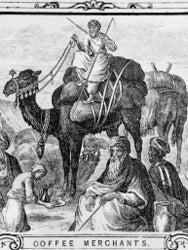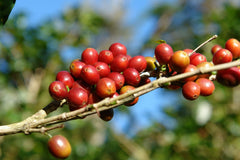 The rise of coffee's world standing from an obscure fruit seed in the 5th century to the most traded global commodity after oil today is remarkable. As the ancestral land of all arabica coffees, Africa and Arabia authored the first chapters of coffee's intriguing history. The "discovery" of Coffea arabica, the botanical species that sold the world on coffee, occurred during the 6th century in a land the ancients called Arabia Felix, meaning Fortunate Arabia, on the southern fringe of the Arabian peninsula.
The rise of coffee's world standing from an obscure fruit seed in the 5th century to the most traded global commodity after oil today is remarkable. As the ancestral land of all arabica coffees, Africa and Arabia authored the first chapters of coffee's intriguing history. The "discovery" of Coffea arabica, the botanical species that sold the world on coffee, occurred during the 6th century in a land the ancients called Arabia Felix, meaning Fortunate Arabia, on the southern fringe of the Arabian peninsula.According to legend, a young Arabian goatherd named Kaldi noted the lively behavior of his goats as they feasted on red cherries from certain wild shrubs. Intrigued, Kaldi consulted with an imam from the local monastery who boiled some of the berries and drank the liquid himself. Uncharacteristically alert during evening prayers, the imam lauded the brew's potency. Word of coffee's effect on mental clarity reached the faithful in short order, including the true source of its stimulant qualities. The coffee cherry had not induced the imam's wakefulness, but rather its seed—the coffee bean.
 Indigenous to Ethiopia, arabica trees were first commercially cultivated in Yemen on the southern point of the Arabian peninsula. By the 15th century, coffee was the beverage of choice in Arabia. Forbidden to drink wine, Muslims had turned to coffee and wove its exotic charm into their culture. Arabian coffeehouses served their celebrated brew to visitors from other countries, and hospitable Arab merchants conducted business with Venetian traders over steaming cups. It didn't take long for news of coffee's allure to spread throughout the world, as would its fertile coffee beans.
Indigenous to Ethiopia, arabica trees were first commercially cultivated in Yemen on the southern point of the Arabian peninsula. By the 15th century, coffee was the beverage of choice in Arabia. Forbidden to drink wine, Muslims had turned to coffee and wove its exotic charm into their culture. Arabian coffeehouses served their celebrated brew to visitors from other countries, and hospitable Arab merchants conducted business with Venetian traders over steaming cups. It didn't take long for news of coffee's allure to spread throughout the world, as would its fertile coffee beans.To maintain its monopoly on coffee production, Arabia vehemently opposed the exportation of its fertile coffee seeds and boiled or parched all beans prior to export to render them infertile. The country maintained its world dominance until 1670 when an Indian holy man on pilgrimage to Mecca became so enamored with coffee and its potential for his own country's economy that he strapped seven fertile beans to his stomach and smuggled them to India. His plantings not only flourished in the Baba Budan hills that bear his name near Mysore, but they spawned an agricultural expansion that would extend to Europe's colonies as well.
Keenly aware of coffee's market potential, Dutch traders lined up to purchase seedlings from Baba Budan's notorious stash. They headed for Indonesia and Ceylon with them, ushering in a new chapter of coffee's history. No longer an Arab monopoly, coffee was about to embark on its long, enormously successful trek around the world.
 As coffee cultivation and production spread, characteristics of the coffee bean became more distinctive from one geographic location to another. Subtle variations in soils, microclimates, and processing methods imparted unique properties to the beans influencing their flavor, body, aroma, and acidity. In essence, coffee from each growing region reveals a distinct flavor or "taste of the place" in the cup—known as terroir—and helps to account for the high regard paid to single-origin coffees. One can literally "drink in" another land and its culture. The influence of geography on the quality of a highly absorbent coffee bean is profound. Consequently, the more celebrated a growing region, the finer the coffee produced there.
As coffee cultivation and production spread, characteristics of the coffee bean became more distinctive from one geographic location to another. Subtle variations in soils, microclimates, and processing methods imparted unique properties to the beans influencing their flavor, body, aroma, and acidity. In essence, coffee from each growing region reveals a distinct flavor or "taste of the place" in the cup—known as terroir—and helps to account for the high regard paid to single-origin coffees. One can literally "drink in" another land and its culture. The influence of geography on the quality of a highly absorbent coffee bean is profound. Consequently, the more celebrated a growing region, the finer the coffee produced there.
Yemen is recognized as the world's first commercial coffee producer and the land of coffee's "discovery," yet botanical evidence indicates that Coffea arabica, the tree which produces the finest of all coffee species, is indigenous to Ethiopia.
Known to have grown wild in the Ethiopian province of Kaffa (meaning coffee), the arabica bean was doubtless used as a medicinal herb for centuries. Precisely how coffee made its way from Ethiopia across the Red Sea into Yemen is mere speculation. Some believe that slaves taken from present day Sudan into Yemen and Arabia through the ancient port of Al Makha (Mocha) are responsible for Coffea arabica's export. The slaves are presumed to have brought coffee cherries with them as a food source. Another plausible theory suggests that Ethiopia's invasion of Yemen in the 5th century and its subsequent rule no doubt introduced coffee to the region.
 The African and Arabian regions shaped Coffea arabica's genesis from obscure fruit seed to exotic beverage. Coffees from this distinguished growing region are legendary for their diversity and share flavor attributes ranging from citrus and spice to chocolate and nut. Some of the region's coffees are still organically grown and hand-processed in accordance with centuries-old tradition. The floral aroma, subtle flavors, and impressive body of these coffees place them among the world's finest.
The African and Arabian regions shaped Coffea arabica's genesis from obscure fruit seed to exotic beverage. Coffees from this distinguished growing region are legendary for their diversity and share flavor attributes ranging from citrus and spice to chocolate and nut. Some of the region's coffees are still organically grown and hand-processed in accordance with centuries-old tradition. The floral aroma, subtle flavors, and impressive body of these coffees place them among the world's finest.
